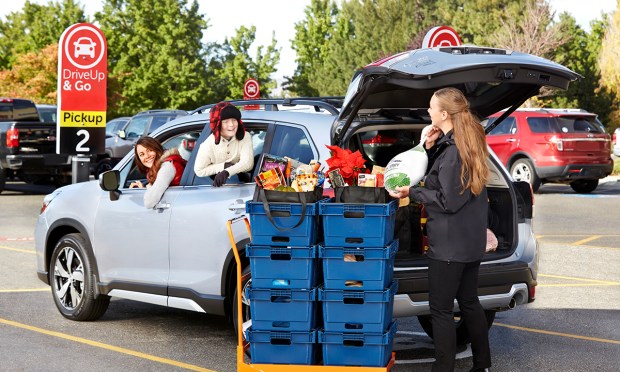
With third-party aggregators looking to drive grocery sales, Albertsons Companies is fighting back, offering new options to maintain consumers’ direct digital loyalty.
The grocery giant announced Wednesday (Sept. 13) the launch of 30-minute pickup and delivery, calling the service Flash, at more than 2,000 stores across seven of the company’s banners.
“Shoppers today want fast pickup and delivery, and Albertsons is meeting this expectation with our new Flash service,” Stephen Menaquale, the grocer’s senior vice president, eCommerce and fulfillment, said in a statement.
The service is accessed through the grocery chains’ apps and websites for delivery or curbside pickup (or DriveUp & Go, as Albertsons calls it). Additionally, the grocer is leveraging this offering to drive the adoption of its paid subscription, FreshPass, offering free 30-minute pickup and $2/order delivery to members. In contrast, non-members are charged $3.95 for Flash pickup orders and $11.95 for delivery.
The move comes as Albertsons and its soon-to-be parent company Kroger look to drive direct digital sales in the face of growing competition from third parties. Grocery aggregator Instacart, for its part, is gearing up to go public via initial public offering (IPO), while DoorDash and Uber Eats have been expanding their grocery offerings.
These efforts appear to be successful. Albertsons Companies shared in its most recent earnings report that digital sales were up 22% year over year, and loyalty membership grew by 16%. Similarly, Kroger shared in its own financial results Friday (Sept. 8) that digital sales were up 12%, with delivery increasing 24%.
Moreover, the Cincinnati, Ohio-based company touted in a presentation shared with analysts that the combined company would have a digital business worth more than $12 billion between the two grocery giants.
A significant share of consumers now orders grocery delivery directly from merchants’ websites. According to PYMNTS’ report “12 Months of the ConnectedEconomy™: 33,000 Consumers on Digital’s Role in Their Everyday Lives,” as of last November, 40% of consumers reported that they had purchased groceries for delivery (not from a third-party aggregator) in the previous month. This makes the channel slightly less popular than curbside pickup, which 41% had opted for, but more popular than in-store pickup (37%) and third-party same-day delivery aggregators (34%).
Additionally, a small but meaningful portion of consumers shops for groceries exclusively via digital channels, per PYMNTS Intelligence from the recent report “Consumer Interest in an Everyday App,” created in collaboration with PayPal, which draws from a survey of more than 2,200 U.S. consumers. In fact, 14% of respondents reported that, in the previous 30 days, they had exclusively purchased groceries using internet-connected devices. Plus, an additional 39% purchased groceries both by using connected devices and via more traditional means.
Smaller grocers are similarly looking to take advantage of this direct digital opportunity.
“In online grocery today, the biggest shift is from independent retailers relying on others in a way that is not sustainable and not profitable to independent retailers, taking the reins and taking control and investing in this channel because of all the value that it can create,” Jeff Anders, co-founder and CEO of eGrocery technology company Grocerist, said in a February interview with PYMNTS.